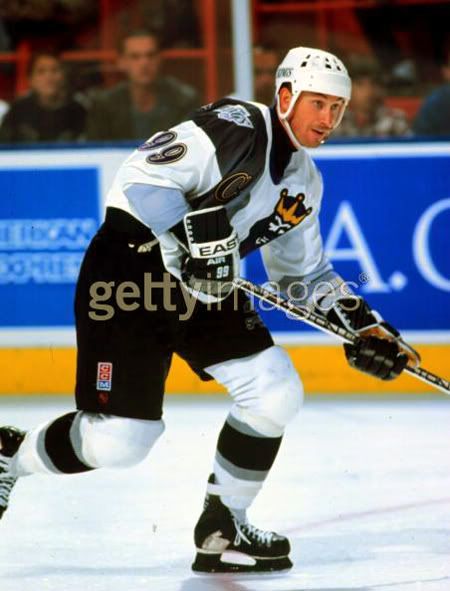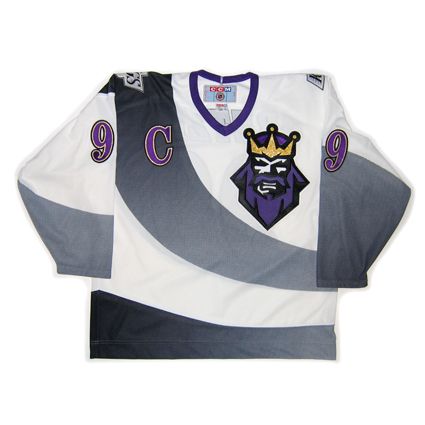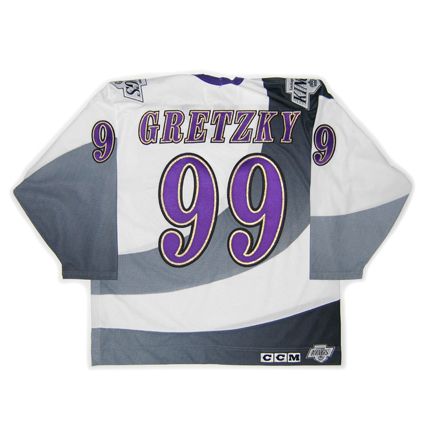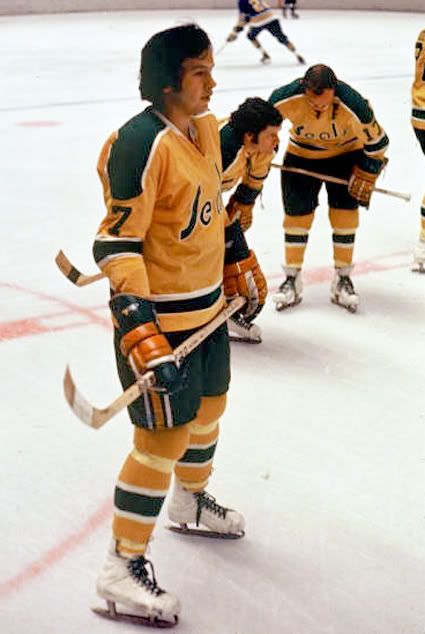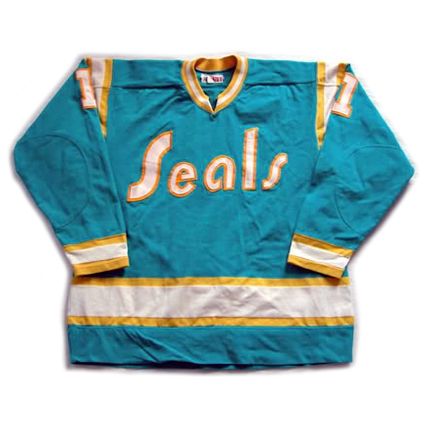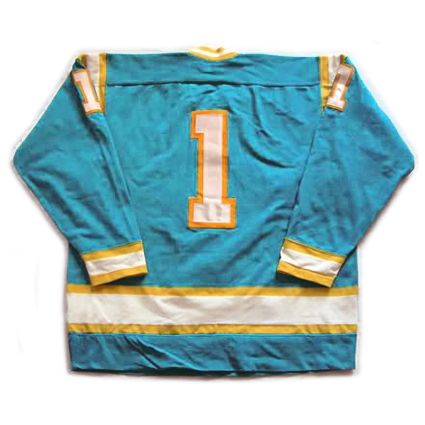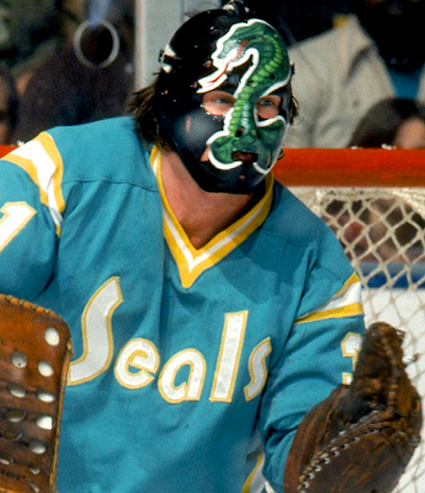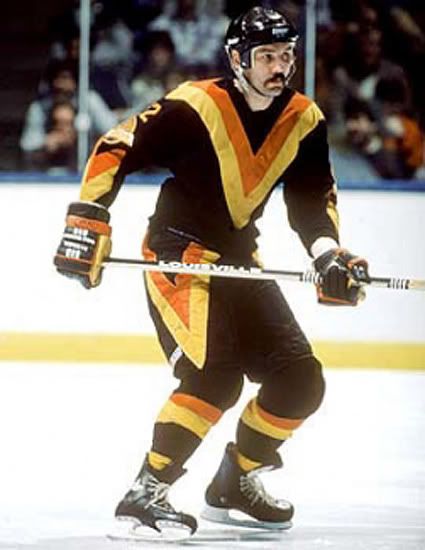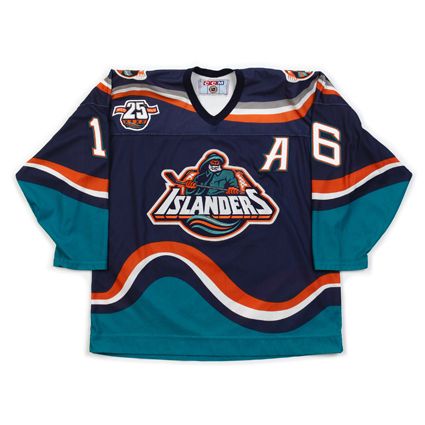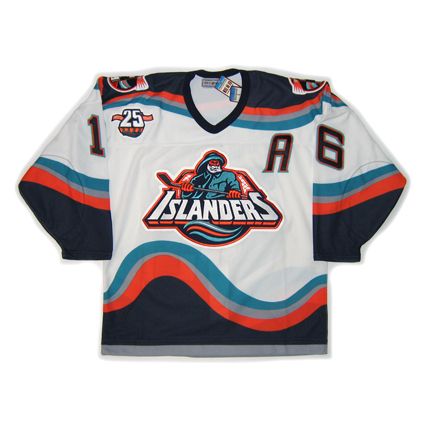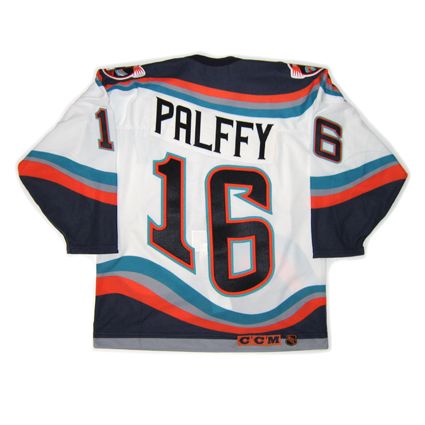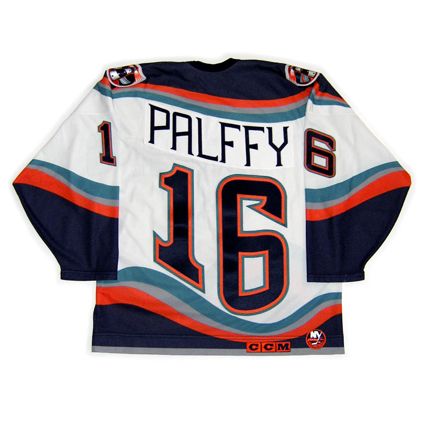Friday, August 27, 2010
1995-96 Los Angeles Kings Wayne Gretzky Jersey
Curious, Weird and Ugly™ makes it's way out to the west coast today for one of the most notorious jerseys in the history of the NHL.
The dye-sublimation printing process rears it's ugly head once more with this 1995-96 Los Angeles Kings Alternate Wayne Gretzky jersey. The jersey features a large swooping stripe that crosses the jersey from the upper right shoulder to the lower left side, fading from dark grey (never quite black) to light while getting narrower in the process. The basic striping pattern of the jersey is unusual, if not odd, enough, but then the Kings got busy customizing it, first adding an angry stylized King's head logo, offset to the upper left chest, something no other jersey of the era, or perhaps in the history of the NHL, dared to do. But that was not all. While the Kings home and road jerseys were exclusively black, white and silver, the King's head logo was done in a garish purple and with a metallic gold crown, one of the earliest uses of metallics in the NHL.
Once the basic jersey was completed, the individual player's identity needed to be addressed. The font chosen for the back and sleeve numbers was a flamboyant, italicized font done in purple, trimmed in metallic gold and outlined in black. The same treatment was given to the names on the back, with the letters also italicized in the same three color combination.
While purple and gold might be associated with royalty, the net effect of the strange swooping stripes, grimacing King's head logo and flashy font executed in the royal purple and metallic gold was much more ridiculous than regal.
Fans dubbed the jersey "The Burger King Jersey", adding it to the list of jerseys so heinous that it earned a coveted nickname. The resemblance between the Los Angeles Kings logo and the fast food chain's creepy monarch is undeniable.
The Kings began wearing this jersey midway through the 1995-96 season, when the first NHL alternate jerseys debuted, beginning with a game against the Mighty Ducks of Anahiem, who also wore their new "Wild Wing" alternates for the first time, on January 27, 1996 in what has to be easily be The Worst Dressed Game in NHL History.
The Kings only wore their new alternates for a mere eight games before the negative reaction of the players and fans caused them to be retired permanently.
It's not known if being forced to wear this jersey caused Wayne Gretzky to ask for a trade out of Los Angeles so he wouldn't have to wear it any longer, but he was dealt to the St. Louis Blues for the last 18 games of the 1995-96 season.
This style jersey was never made in an authentic version for retail, so there are none available outside of game worn or team issued with fight straps. They are highly sought after by collectors and usually attract multiple bidders when they come up for auction, no doubt due to their scarcity, but more importantly the fact this style was worn by Gretzky, meaning not only collectors of ugly jerseys want the "Burger King" jersey, but also collectors of rare jerseys as well as people who specialize in Gretzky items are all after the same limited supply of one of the worst jerseys to ever see the ice in an NHL contest.
We classify this jersey as "Weird", due to the curving, radiating grey stripes that fade from dark to light, the newly introduced grimacing Burger King logo, the name and number font that would look more at home at Mardi Gras than on an NHL jersey, the addition of the color purple to a Kings jersey during the black and silver era, and finally the use of the flashy metallic gold for the number trim and King's crown.
Also weird is the fact Wayne Gretzky agreed to wear it at all. There's really not a single element of this jersey that isn't weird.
Let us reword that last sentence.
There's not a single element of this jersey that isn't really weird.
Here are the Los Angeles Kings debuting their new alternate "Burger King" jerseys against the Mighty Ducks of Anaheim, who were wearing their "Wild Wing" jerseys in what ranks as The Worst Dressed Game in NHL History.
Next Ugly Fest '96 between the Kings and Mighty Ducks continues as Wayne Gretzky sets up Jari Kurri for a power play goal.
Labels:
Curious Weird and Ugly,
Los Angeles Kings
Thursday, August 26, 2010
1974-75 California Golden Seals Marv Edwards Jersey
The ever name changing California Seals were founded as part of the great NHL expansion of 1967-68. The San Francisco area was not considered a particularly lucrative market for hockey, but the terms of a new television agreement with CBS call for two of the six new expansion teams to be located in California, with the other being the Los Angeles Kings.
The team was supposed to have been located in San Francisco, but the arena was never built and instead, the team was based across the bay in Oakland. First called the California Seals to appeal to fans in San Francisco and address complaints from other NHL teams that complained that Oakland was not considered a major league city, as it's only other professional sports team at the time was the Oakland Raiders of the American Football League. On November 6, 1967, owner Barry Van Gerbig announced that the team's name was being changed to the Oakland Seals.
Poor attendance led to Van Gerbig threatening to move the club and a poor record on the ice led to only seven of the original 20 players remaining on the team in it's second season. While they did finish with records below .500, they would make the playoffs for the next two seasons, the only times the club would qualify for the post season in their history.
Van Gerbig sold the team to a group called Trans National Communications in time for the 1969-70 season, but when the group filed for bankruptcy, ownership reverted to Van Gerbig, who put the club up for sale again.
The Oakland Seals were then purchased by Charlie O. Finley, owner of the Oakland Athletics baseball club, who had moved to the bay area in 1968. Never one to sit still, Finley renamed the team the California Golden Seals and altered the team's green and blue colors to green and gold, matching those worn by his baseball club, as well as having the team wear flashy white skates!
Unfortunately the the Golden Seals finished dead last in the NHL during their first season under Finley's ownership with just 45 points from 78 games. Even worse,their first overall pick in the 1971 NHL Entry Draft, along with Francois Lacombe, had already been traded to the Montreal Canadiens for their first round pick in 1970, used by he Golden Seals to take Chris Oddleifson, Ernie Hicke and the always useful cash. The Canadiens used the draft choice obtained from the Golden Seals to select future Hall of Famer Guy Lafleur.
The team improved by 15 points the following season, but suffered from the emergence of the World Hockey Association, as the frugal Finley refused to match the WHA's contract offers to his players resulting in five of the team's top ten scorers leaving and the Golden Seals once again sank to the bottom of the standings with 48 points in 1972-73 and followed that up with just 36 points in 1973-74.
Matters were made worse, if that's possible, by a divisional restructuring which somehow found the Golden Seals placed in the newly created Adams Division with the Boston Bruins, Buffalo Sabres and Toronto Maple Leafs, in an apparent effort by the league to kill off the franchise, as each of the other clubs were a minimum of 2300 miles to the east!
Having grown tired of owning the hockey team, especially in direct comparison to his World Champion baseball team, Finley tried unsuccessfully to sell the Golden Seals, which were eventually eventually taken over by the NHL.
Melvin Swig then purchased the team in 1975 with plans to have the team play in a new arena in San Francisco. Those plans never came to pass following the election of a new mayor opposed to the plan, so after nine money-losing seasons, low attendance and few victories, minority owners George and Gordon Gund convinced Swig to relocate the team to their hometown of Cleveland, Ohio, a move that was announced on this date in 1976, making the club the first NHL team to relocate since 1934 and bringing to and end the Golden Seals ordeal in California, where the team had more names than playoff appearances.
Politically, Swig and the Gunds were relying on Swig's political connections with San Francisco Mayor Joseph L. Alioto to get a new hockey arena built downtown. "Alioto was very helpful, " Gund remembered. "He had hoped to put the team where the Moscone Center is now. It was very close to public transportation."Regrettably for the Seals, Swig's timing was off. Alioto was leaving office and Swig supported the wrong man in the 1975 election. When George Moscone took office, the new arena died. "The new mayor put the building on hold." Len Shapiro said. "He ran an investigation into the report and then said the survey had to be resurveyed , so basically, it went nowhere. Then there were plans to remodel the Cow Palace but that never happened either." Once those two plans fell through, the Seals were finished in the Bay Area."After the new arena in San Francisco fell through, the league gave us the go-ahead to move the team." Gund remembered. "We looked at a lot of other places. We looked at Denver and Seattle-Tacoma. We ended up picking Cleveland because hockey was very popular there."Rumors that the Seals would leave the Bay Area were almost as old as the team itself. The owners were quietly but aggressively looking over other locations. The NHL had planned expansion franchises for both Seattle and Denver, which were supposed to begin play in 1976-77. The new entires, though, were experiencing problems so moving the Seals to those cities was still a possibility.Shapiro recalled when he first got an inkling the team might be leaving. "On February 1, 1976, I realized something might be up. I was in the office with Loretta Marcus [the team's secretary] and nobody else was there. I had no idea where anybody was. I looked at Munson Campbell's schedule and it said he was booked at the Cleveland Hilton. Then I knew something must be up."George and Gordon Gund owned the Richfield Coliseum in Richfield, Ohio, where the NBA's Cleveland Cavaliers played. It was halfway between Akron and Cleveland, a location that would cause the franchise more problems in the future. In typical Seals fashion, even it's exit was not smooth. The club participated in the July 1976 entry draft as the Seals and even started selling tickets for the upcoming season in Oakland.At the 1976 entry draft, the Seals made history by becoming the first NHL team to use its frist-round draft pick on a European player by drafting Swedish defenseman Bjorn Johansson. The team didn't make it's intention to move officially known until August 26, 1976. It was announced that the team would move to Cleveland and take the name of the AHL franchise that played there for so many years, the Barons. Because of the late move, the Barons had a mere six weeks to sell tickets in their new home. Once again, the franchise started its new life behind the proverbial eight ball.
Under the Gunds ownership, the Barons played in Ohio for two seasons, merged with the Minnesota North Stars, who were then sold to another group while the Gunds received an NHL expansion franchise, the San Jose Sharks, at the south end of San Francisco Bay, 40 miles from where it all started.
Today's featured jersey is a 1974-75 California Golden Seals Marv Edwards jersey. After the departure of owner Charlie O. Finley, the Golden Seals colors were changed from his signature green and gold to the even less intimidating "Pacific Blue" (teal) and "California Gold" (yellow), quite probably the worst colors for an NHL team ever, and also giving the team more color schemes in the end than playoff appearances as well.
Another odd characteristic of these jerseys were the decidedly "football jersey" vertical stripes where the arms meet the body of the jersey, something we don't believe has ever appeared on an NHL jersey before.
We actually had not planned on including these jerseys in the "Curious, Weird and Ugly" Collection of the past couple of weeks, originally planning on simply a look at the Seals history on the anniversary of their move to Cleveland, but the more we looked at their final teal and yellow set of jerseys, the worse they looked and the more we knew we had to add one more to the collection. We rate this jersey as "Curious", "Weird" and "Ugly", for a rare trifecta.
Curious are the football stripes on the upper arms, while weird is the choice of pastel colors for a team in a full-contact sport. Honestly, I've seen more intimidating Easter eggs. While the gold and purple of the Los Angeles Kings was unorthodox, it was at least explainable as relating to the colors of royalty and the purple dark enough to offer some contrast to the gold while the choice of teal and yellow leaves me repeating "Only in California" as the whole package of odd striping, inappropriate colors and bland logo can only add up to ugly without a doubt.
Not even the addition of goaltender Gary Simmons' black goalie mask with a frightening green cobra was enough to offset the "only in California" colors of the Golden Seals final jersey set.
Here are some fantastic old videos of the Seals in action. Check out those rinkside seats for $5.50 and playoff tickets for $12. Sign me up!
We don't care how hard you punch, there's just no dignity in wearing those teal jerseys.
Wednesday, August 25, 2010
1980-81 Vancouver Canucks Richard Brodeur Jersey
Today's Curious, Weird and Ugly™ Collection jersey sees us return to Vancouver once more with one of the strangest and unforgettable jerseys to ever see the ice in an NHL contest.
From the Canucks inception in 1970-71 to 1977-78 the Canucks wore blue and green jerseys, another one of those lame "blue for water, green for trees" jerseys where a professional sports team feels they must be the leading voice for the local board of tourism. Well, in 1978 all that came to an abrupt end.
Before the 1978-79 season the Canucks hired a professional psychologist to redesign the uniforms. The old colors were determined to be "too bland, too tranquil and did not inspire emotion." The result was the "V" design, suggesting "victory" according to the designer. The bright orange was said to "evoke passion and aggression" while the black road jersey would instill fear in the opposition.
The jerseys featured no main team logo on the front, but instead a giant "V" shape done in bright orange and yellow on a black jersey. The sleeves also featured smaller "V" shapes midway down the arm with a new "Flying Skate" logo for the shoulders and the very unusual placement of the sleeve numbers at the very bottom of the arms on the wrists!
The "V" shape was not limited to just the jerseys either, as the breezers had giant multi-colored "V's" as well. During the first year these jerseys were worn, they even had "V" shaped stripes on the socks.
The Canucks introduced the jerseys, which none of the players had seen prior to the game, at the season opener in Minnesota. As Stan Smyl said, "I've never been ashamed to wear the Canuck's uniform, but that night none of us wanted to leave the dressing room."
They were met with much derision around the NHL and were often referred to as "those Halloween suits". Vancouver nearly got the last laugh however, as they made it all the way to the Stanley Cup Finals in 1982 before running smack into the New York Islanders dynasty, which was in full stride. Time has settled on the nickname of "The Flying V" for these jerseys.
The basic jersey produced in 1978 remained in use until the 1984-85 season, but with a few adjustments along the way, such as a change in color for the names on the back, relocating the very unconventional sleeve numbers from the wrists to the shoulders and eventually evolving from one color names and numbers to two colors for both.
Some feel that the Canucks have never gotten it right, as the original logo was too simplistic, the Flying V was too hideous, the Flying Skate was too busy and the Orca logo too corporate, as the Canucks were owned by Orca Bay Entertainment when the Orca/Killer Whale logo was adopted.
This online exchange seems to sum up the Canucks jersey history quite succinctly.
Q: "Why are the Vancouver Canucks jersey's always ugly?Seriously, there [sic] always horrible. Do the designers for Vancouver really think they look good? I always get a headache watching them play.Vancouver fans, please answer! Please explain why you have idiots as designers?"A: "I thought it was a league rule. Vancouver must always have the ugliest sweaters."
Maxim magazine, which I only read for the articles, rated the Flying V jerseys as "The Worst Sports Uniform" in any sport.
The only patch the Canucks wore on the Flying V jerseys was a "JCM" memorial patch to honor former GM Jake Milford in 1984-85.
We classify this jersey as "Curious" and "Weird". Many consider it ugly, but we're actually quite a fan of the whole idea of trying to design a jersey in an effort to aid your team in victory. It took some bold thinking and a lot of guts for the designer to create it, and then even more for the club to support the concept and stick with it for seven seasons. I can't see anyone in the NHL being bold enough to risk the large amounts of income clubs rely on from the marketing of jerseys by trying something so far outside the norm these days.
Yes, they are weird, when compared to the jerseys of the day, quite weird. One almost wonders why they even bothered to include the tiny sleeve numbers on the cuffs since they are so small and out of the way. The "Flying V" jerseys are also certainly a curiosity, as no other team followed them down the same path, leaving the "Flying V" as a truly unique chapter in NHL history.
This first example is a 1980-81 Vancouver Canucks Richard Brodeur jersey with the one color names and numbers with the sleeve numbers on the cuffs as worn during their second season of use.
This second example is a 1982-83 Vancouver Canucks Dave "Tiger" Williams jersey showing the evolution of the design, now with two color names and numbers and now having the sleeve numbers relocated to a more traditional shoulder location.
Here are some highlights of the Flying V jerseys in action, particularly from the Canucks 1982 Stanley Cup run.
Labels:
Curious Weird and Ugly,
Vancouver Canucks
Tuesday, August 24, 2010
2002-03 Nashville Predators Tomas Vokoun Jersey
Today the Curious, Weird and Ugly™ Collection features yet another alternate jersey, which raised the question, "Is "alternate" Latin for hideous?"
First unveiled for the 2001-02 season, this Nashville Predators alternate jersey generated swift, outspoken reaction to just about every feature of the jersey, from the unusual squared neckline, the "untucked dress shirt" rear tail, both the borderline cartoonish new main crest and the secondary fossilized skull logo, neither of which appeared on the home and away jerseys at the time, and the unique double layered fabric of the body of the jersey.
First unveiled for the 2001-02 season, this Nashville Predators alternate jersey generated swift, outspoken reaction to just about every feature of the jersey, from the unusual squared neckline, the "untucked dress shirt" rear tail, both the borderline cartoonish new main crest and the secondary fossilized skull logo, neither of which appeared on the home and away jerseys at the time, and the unique double layered fabric of the body of the jersey.
But drawing the most reaction, of course, was the unexplainable choice of the strange and repulsive mustard color of the jersey, which has been compared to, among other things, puss, vomit, urine and baby poop!
Most of the successful alternate jerseys simply promoted a teams third color to the main color for it's alternate, such as the Chicago Blackhawks did with their black jerseys, but Nashville instead tried to reinvent the wheel, coming up with a new jersey cut, carried over no logos from the primary jerseys and made the new alternate not only a color not found in their existing color palette, but picked perhaps the most horrid color ever used on a professional sports team's jersey to compound the problem.
The jersey was used through the 2006-07 season and did influence the home and away jerseys, to some degree, as it's secondary fossilized skull logos were transferred to the shoulders of primary jerseys for the 2005-06 season, replacing the original design used since the team's inception.
Not only was the color of the jersey unique in the NHL, the jersey fabric was as well. It used a mustard colored top mesh layer over a solid dark blue layer, which shows through the holes in the mesh of the mustard layer, making an already muted color appear even darker and muddier.
The jersey was used through the 2006-07 season and did influence the home and away jerseys, to some degree, as it's secondary fossilized skull logos were transferred to the shoulders of primary jerseys for the 2005-06 season, replacing the original design used since the team's inception.
The only patch worn on this jersey was the Nashville Predators 5th Anniversary patch in 2002-03 as shown below.
We classify this jersey as "Ugly" due to the awkward neckline, overly detailed primary logo, strange fabric construction and horrendous color choice. If your jersey is conjures up repeated comparisons to various unpleasant bodily fluids, you have an ugly jersey on your hands.
Here are a pair of videos that seem to suggest that the Detroit Red Wings and the Dallas Stars hate the Predators alternate jerseys as much as we do.
Monday, August 23, 2010
1996-97 New York Islanders Ziggy Palffy Jersey
The Curious, Weird and Ugly™ Collection now recalls a jersey so despised that opposing fans used it as a chant to taunt the team wearing it.
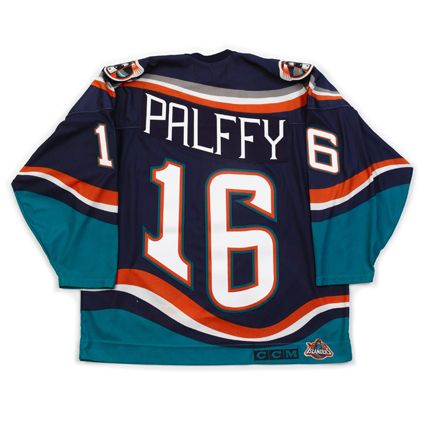
We give you the one, the only, 1996-97 New York Islanders "Fish Sticks" jersey.
Kirk Muller popped into the home dressing room at Nassau Coliseum on a sunny June afternoon during the Stanley Cup finals in 1995. This was the big debut of the Islanders' new uniforms, the first glimpse of what many fans and media members immediately crowed was a blasphemous move by management to make a final break from the team's storied past.The public relations fiasco that would be known as the Islanders' 1995-96 hockey season actually started near the end of the previous campaign, when Don Maloney committed the signature sin of what would be a short tenure in the general manager's office. He traded his best player, Pierre Turgeon, in a five-player deal for Kirk Muller, a widely respected leader who simply wanted no part of leading the Islanders bak to the playoffs after they failed to qualify during the lockout-abridged 1994-05 season.If Maloney's worst crime was his misguided belief that his first blockbuster move would benefit he Islanders on the ice, the four-pronged managment group's decision to alter the team's fashion sense only accelerated their transformation into league laughingstocks."We never intended to strip the team of it's tradition," Islanders co-chairman Bob Rosenthal said. "But we made a mistake. We did not read the signals correctly. We misunderstood the underlying passion of the fans."The team's dwindling yet impassioned fan base never forgave (former Islanders General Manager Don) Maloney for the Turgeon trade, not even after Maloney and (Kirk) Muller were both mercifully expunged from the organization over the next nine months. But the logo fiasco served as a rallying point for a segment of fed-up paying customers who suddenly found themselves forming activist groups and oranizing protest rallies rather than worrying about the power play or Stanley Cup playoffs."We believed that many of the people who had followed the team in the late seventies and eighties had moved off the Island," Rosenthal said. "Their kids had grown, and maybe they moved away as well. The season ticket base, which had been 13,000 to 14,000 at it's peak, had dropped to 5,000, so we not only were looking to improve our play on the ice, we started looking for ways to attract new fans."In retrospect, the probably should've found another way.For the first 23 years of their existence, the Islanders' uniforms were adorned with a simple logo, a circled crest of Long Island that also included an "NY" with the "y" appearing in the form of a hockey stick. It was designed on just three days' notice by John Alogna, who owned a Garden City ad agency, in 1971, and it quickly became synonymous with the Islanders as they ascended from expansion franchise to NHL champions.Still, after the 1993-94 season ended in a disgraceful first-round playoff sweep by the Rangers, Islanders management "began to feel that younger fans were starting to think about the old logo in terms of the futility of the previous years, not the four Stanley Cups," according to Rosenthal.The NHL, buoyed by the marketing and sales success of merchandise adorned with logos of new franchises such as the Mighty Ducks of Anaheim and the San Jose Sharks, encouraged the Islanders to consider making a change, more in line with other cutting-edge sports fashions. The league recommended SME Design in Manhattan, which had modernized the uniforms of the St. Louis Blues and also designed the logo of the expansion Florida Panthers and other pro and college teams.Initially, Walsh and vice president of communications Pat Calabria served as the point men for ownership."The Islanders were living in the shadow of the Rangers," designer Ed O'Hara toldNewsday's Steve Zipay in 1997. "We all agreed that a strengthened tie to Long Island was important, to keep the heritage of the Island and amplify it. Savvy marketers will tell you to think locally."As New Coke and Pepsi Clear showed, sometimes it's better to leave well enough alone.Walsh, who allowed his children's opinions to influence his decision, had a vision of a maritime theme. SME submitted a proposal to the Islanders with three to five concepts. In April, designs with various colors and logos of a lighthouse, a bearded grimacing mariner and the steering wheel of a fishing boat were offered."Everyone agreed that the bayman was the one, although the entire process was a huge concern. There was always self-doubt," O'Hara said. The NHL approved the entire concept in early fall of 1994 for implementation during the 1995-96 season.Beat writer Colin Stephenson of the Daily News was the first to report the changes and updated colors, remarking how the chosen logo resembled the frozen-food advertising icon Gorton's fisherman. In a photograph accompanying the story, former captain Denis Potvin was pictured hoisting the Stanley Cup while wearing a computer-generated uniform adorned with the new logo and deeper color schemes. SportsChannel announcer Stan Fischler was cited as bearing a remarkable resemblance to the logo fisherman.Barely one week after the official introduction on June 22, 1995, 78 percent of 1,006 respondents to a Newsday poll asking for responses panned the new logo. To prove there's no accounting for the taste of the consumer public, Team Licensing Business, a publication that tracks purchases of sports apparel, reported as of March 31, 1996 that the Islanders have moved up to No. 17 of the 26 clubs in jersey sales. According to the NHL, that was three or four slots higher than the previous season.Still, the Islanders fans deplored the blasphemous changes, with many comparing it to the Gorton's fisherman. That comparison prompted Rangers fans to mockingly chant, "We want fish sticks!" when the Islanders visited Madison Square Garden for the first time that season.Peitions were drawn up and signatures gathered. The Gang of Four was chided mercilessly at Nassau Coliseum, including an ugly incident in which Palleschi's teenaged daughter was booed while singing the National Anthem before one game. A small but vocal contingent of disgruntled fans even formed a group that initially was spawned in protest of the logo."With change comes risk; with change comes unhappy fans," Rosenthal said. "As the team continued to lose, fans needed something to cling to and homed in on the logo. We began to realize it was not dying down. In the final analysis, we didn't want our fans or players to be subjected to ridicule for something other than our play."To be sure, there was plenty of room to mock all aspects of the operation. Ultimately, the one thing that all sides agreed on was that the fisherman logo became the lightning rod for all of the team's misfortunes and the focal point of fan frustration "There's no doubt it was the scapegoat. But winning would have helped," O'Hara said.On April 11, 1996 - a few games before the end of another disastrous season - the Islanders announced plans to restore the old logo for 1997-98 while retaining the new colors and wavy designs."Good," Islanders defenseman Darius Kasparitits told reporters after he was informed of the reversal back to the original logo. "We looked like idiots."
First used in the 1995-96 season, the new Islanders home and away jerseys would immediately receive scorn and ridicule from both the media and fans alike. The comparison of the new logo to the Gorton's fisherman logo, from the well known brand of frozen fish sticks, would spawn chants by Rangers fans of "We want fish sticks! We want fish sticks!"
Aside from the logo, the jerseys too were such a radical departure from the classic look of the previous jerseys worn during the Islanders' Stanley Cup dynasty that they were doomed from the start. The basic Islanders color scheme of blue and orange was retained for the most part, but the addition of generous amounts of teal combined with the wavy waist stripes and rolling shoulder area, plus the addition of the rising and falling font for the names and numbers on the back, gave the whole look of the jersey the appearance of a seasickness generating permanent state of motion.
After two seasons on the ice, the Islanders began to phase out the fisherman logo, returning the classic "Long Island/NY" logo to the wavy jerseys as an alternate for the 1996-97 season and the exclusive jersey for the 1997-98 season. The season after that would see a wholesale return to an updated version of the four time Stanley Cup winning classic jersey, this time with three color numbers and four stripes on the shoulders to symbolize the team's four championships.
The fisherman jersey, while only used for two seasons, did sport a patch in 1996-97 for the Islanders 25th anniversary season, worn on both the fisherman and NY logo alternates.
We classify this jersey as "Curious". We can see the new Islanders owner's desire to rebrand their failing franchise at the time and actually find the blue road jerseys with the original "NY" logo to be quite striking and far from "ugly" in our book. We particularly like the secondary lighthouse logos and the attempt to break out of the mold of block numbers so commonly used at the time by creating a unique numbering font.
And this jersey is not nearly as "weird" as the Coyotes alternate since we can understand what they were trying to accomplish. If the Islanders had actually won a few playoff rounds while wearing these, perhaps the public would have given the jersey a fair chance on it's own merits, rather than making it "the lightning rod for all of the team's misfortunes".
The resemblance of the logo to the Gorton's fisherman is best qualified as "unfortunate", as having the rival New York Rangers fans mocking the Islanders because of the jersey meant it was never going to receive a fair shot at acceptability on Long Island.

Bonus jersey: Today's bonus jersey is the home version of the Fisherman jersey. Note the different font for the alternate captain's "A", as they changed in January of 1997 to an italicized version of the font used for the player's names on the back, with the top and center bar of the A being parallel.
Extra Bonus Jersey: Our extra bonus jersey is the 1997-98 "transition" jersey with the original "NY" logo returned to the front of the wave jersey template. For the 1997-98 season, the "A" changed once more to a non-italicized version of the player name font, but now with the horizontal bar slanting upward.
This particular jersey has the Slovakia flag patch worn by Palffy only for the 1998 NHL All-Star Game Super Skills Competition in recognition of the new North America vs. The World format for the All-Star Game that season.
This particular jersey has the Slovakia flag patch worn by Palffy only for the 1998 NHL All-Star Game Super Skills Competition in recognition of the new North America vs. The World format for the All-Star Game that season.
Here's a quick video of ESPN introducing the Islanders' brand new uniforms and getting a stamp of approval from Gary Thorne.
We have a second video for you which quite nicely sums up the Fish Sticks era for the Islanders, as they are getting pasted by the Hartford Whalers in yet another classic jersey matchup.
For further reading, we recommend the Islander's longtime Media Relations Vice President Chris Botta's blog entry entitled, "The Tale of the Fisherman Jersey or Shame and Mutiny on the Bounty".
Labels:
Curious Weird and Ugly,
New York Islanders
Subscribe to:
Comments (Atom)


